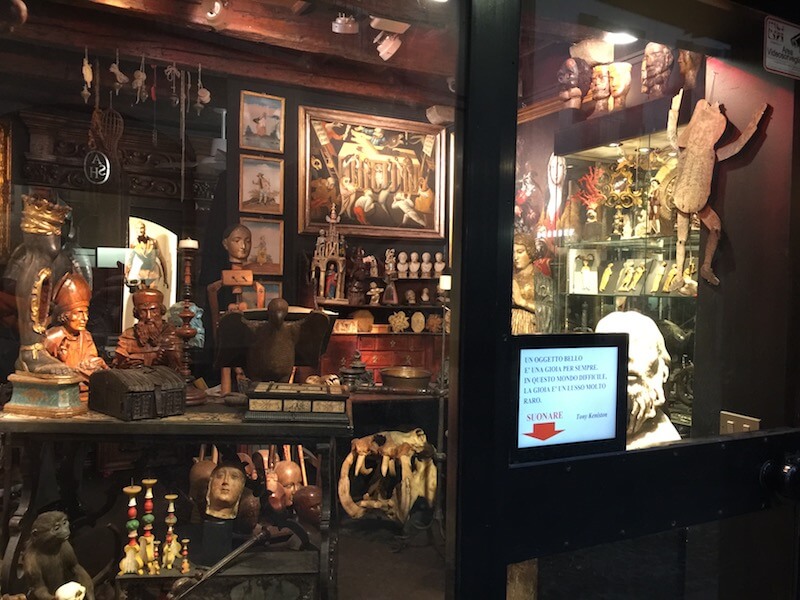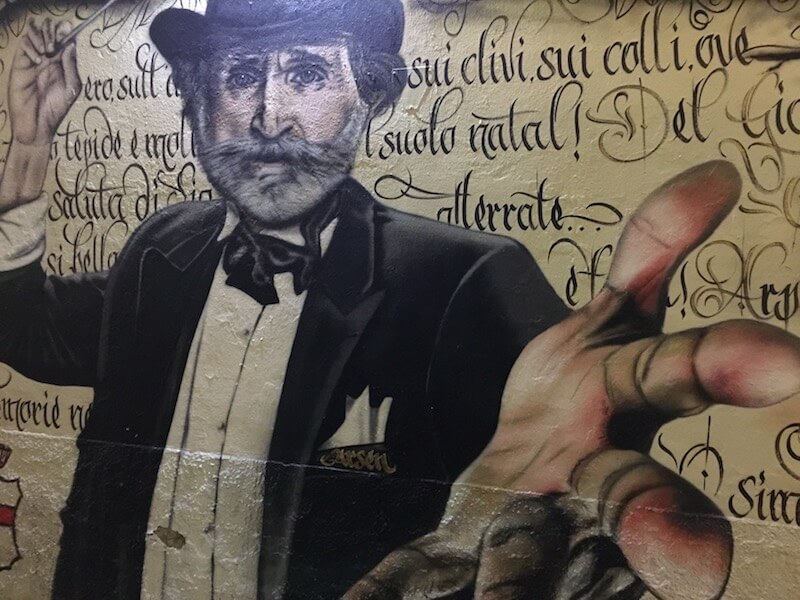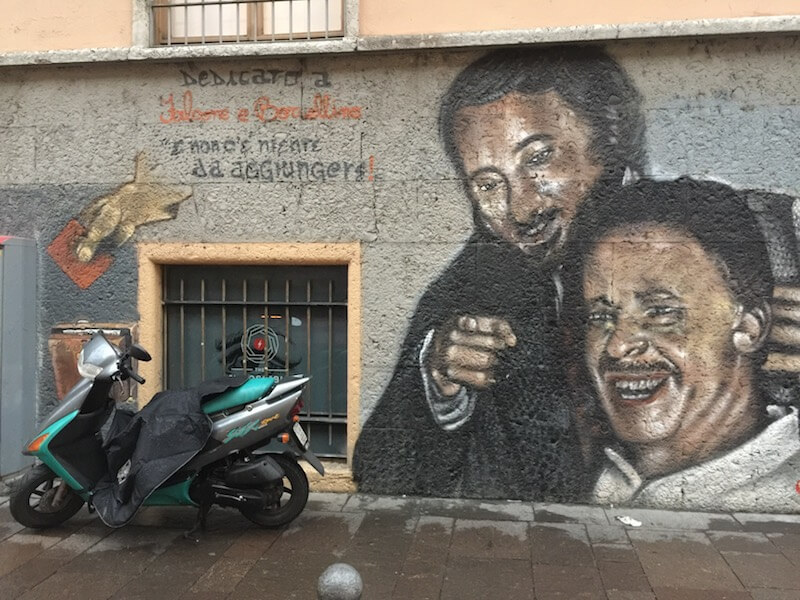I’d heard all about the fashion and the architecture but I only had a weekend, so I wondered: Is Milan worth visiting if you only have a short time?

Is Milan worth visiting for a two-day trip?
As the train pulled into Milano Centrale train station, I looked at the sky – dark, gray, a fog so dense it shielded the top floors of the scattered skyscrapers we passed. I hugged my umbrella tightly, wondering how I would spend the next 48 hours frizzing and freezing.
I already knew Milan’s city center was quite compact (making it possible to visit major sights in a short time), and I was armed with my list of things to see in Milan:
- Da Vinci’s Last Supper, for which I’d bought a ticket beforehand, and which is one of the best things to do in Milan.
- the Galleria Vittorio Emanuele II, because I love patterned floors and cut glass ceilings (and – ceilings mean no rain)
- The Brera neighborhood, which I planned to walk around in search of street art
- and I wanted to go to the top of the Duomo.
That was the plan.
Here’s how it turned out.

The Duomo in Milan
Having visited Milan city as a child, I had vague memories of the Duomo’s spires soaring into the summer sky. Just like in the above photograph.

But the reality was more like… THIS.
Rather than pay for a rooftop visit (soaring over 65 meters / 215 ft into the sky) and see nothing but a few flying buttresses, I instead circled the Duomo Cathedral’s exterior, taking in the carved stonework and massive doors, while fighting off wet umbrellas. It was simply too cold to even consider the damp and dark interior.
Some people despise its mishmash of styles, others love its majesty – but Italy’s largest cathedral probably won’t leave you unmoved. Every inch appears carved (because it is): the Duomo has 3400 statues, more than 130 gargoyles, and hundreds of carvings. It is more decorated than any other building in the world.
What a wonder it is! So grand, so solemn, so vast! And yet so delicate, so airy, so graceful!
—Mark Twain on the Duomo Cathedral, from “The Innocents Abroad”
Building started in the late 1300s in white and pink marble brought in along the canals, the navigli now lined with cafés and restaurants.
For centuries, architects labored over the nave but even after it was consecrated, building continued on and off. The facade was finally completed by Napoleon, who wanted it for his coronation as King of Italy – a title he had added to the many he already had.
It is not even finished yet. Apparently, there’s still a bit of carving to be done…
The Galleria
As the rain sliced across me I decided to seek refuge in the Galleria, one of the world’s oldest shopping malls, built in 1877.
Although it has a giant glass and cast iron ceiling, its ends are open to the street so you’re inside, but outside. Shaped like a cross, each four-storeyed ‘avenue’ is lined with shops and cafés. I mean, who doesn’t want to sit and watch the well-dressed Milanese amble by?

In all the excitement of looking up at the 17-meter-tall ceiling, I had somehow overlooked the bull’s balls.

One of the coats of arms etched into the floor belongs to the nearby city of Torino, which in Italian means little bull.
According to legend, a man may have fallen to his death while building that glass ceiling – right where the bull is located. For some obscure reason, it is considered good luck to grind your heel into where the bull’s testicles should have been and then twist around (backward) three times.
Visiting the Last Supper
And now it was time to visit Leonardo da Vinci’s Last Supper, painted on the wall of the refectory of Santa Maria delle Grazie and the most popular of the many Milan tourist attractions.
A little backstory: the painting captures a single moment when Jesus reveals someone at the table is about to betray him. Waves of emotion move across the apostles’ faces… surprise, shock, anger. It is painted on the wall using a technique Leonardo invented specifically for this particular work of art. Sadly, the technique didn’t work, the paint came off, and every effort to restore it made it worse.
It is a large painting and takes up the entire wall of the room that houses it, but it is incomplete since a doorway was built below it, cutting off part of the bottom, including Jesus’s feet.
The miracle of the Last Supper is its survival. It was used for target practice by Napoleon’s soldiers, and the building was bombed during World War II, yet the painting, protected by scaffolding and sandbags, made it through.
So I knew this would not be a pristine work of art, a perfect painting. On the contrary, I expected to see something old, perhaps even neglected.
The painting is high on the wall, and relatively distant from the audience. These are necessary precautions, given the Last Supper’s fragility and the potential dampness of centuries-old walls.
The visit is highly organized – and rightly so. Thirty people are let in at a time, on schedule. The doors ahead open once everyone is in the room, keeping out the natural elements so dangerous to the painting’s survival.
But for me, it was hard to see. The (necessary) gloom of the refectory made the expressions of the faces difficult to discern, the folds of the clothing, and the shapes of hands and feet fuzzy. I would have liked a few well-lit panels nearby to explain what I was seeing, so be forewarned – because you can do a lot better if you prepare.
My first suggestion is to do plenty of research, knowing you won’t see things clearly once you’re there. Memorize the painting before you go, and know exactly what you’re looking for. Second, hire a guide. A gentleman near me had done that but no matter how far I leaned over I couldn’t hear the. A guide will fill in the (many) blanks and answer your questions – trust me, you’ll have plenty.

I’m thrilled to have been in the same room with this treasure, and I could feel its mysteries and its power. But I could kick myself for not having prepared my visit better.
And so off I went to Brera to look for street art.
Street art in Milan
Here’s what I found instead.

It is a cobblestoned neighborhood, filled with eclectic shops, a smattering of cafés, and dozens of pizzerias whose quality reflects the absolute certainty that you’re a tourist and will probably never be back. There are apparently a few excellent restaurants in the area – but I wasn’t to find them on this visit.
Nor was I to find street art.
Someone may have had fun with a translation and substituted street art for artists because yes, there were plenty of artisans, but any graffiti would have been instantly scrubbed off Brera’s gentrified walls.
I did find street art, though, courtesy of a Milanese friend who guided me to a place I’d never heard of: the columns of San Lorenzo, a series of 16 impeccable Corinthian columns in front of the Basilica of the same name. I saw street art around a corner, and down another, but I know I barely scratched the surface, given Milan’s fine artistic reputation.



Suggestions for art of a different sort led me to the 16th-century San Maurizio al Monastero Maggiore, which Milanese describe as a mini-Sistine Chapel.
San Maurizio al Monastero Maggiore
The unprepossessing former church sits on the Corso Magenta, just down the street from the Last Supper. If you didn’t know, you’d walk right past it.
Once through the doors, a small patio encloses disparate antiquities of Mediolanum, the Roman name for Milan – a frieze here, a column there, a bit thrown together but unexpectedly informative about the way life used to be around these parts and not surprisingly, given that the Archeological Museum is right next door.
The sky remained gray and gloomy, but the church was the perfect antidote to the winter outside. Again, someone knowledgeable to comment on what I was seeing would have been helpful and I should have taken a tour.


High Fashion and Luxury Shopping
Milan truly brings luxury shopping to new heights, and vies with Paris as the fashion capital of Europe, from its major fashion names (Armani, Versace, Dolce & Gabbana, to name just a few) to the upscale Quad d’Oro (Quadrilatero d’Oro) shopping area.
For something completely different, Europe’s largest outlet mall, Serravalle, is nearby. Why not go for the day?
Top 5 Milan must-see locations for solo travelers
If I were to list my top five attractions in Milan for a weekend, here’s what they would be:
1. San Maurizio – absolutely stunning and unexpected
2. A walk around the Galleria Vittorio Emanuele II while admiring the gorgeous glass ceilings
3. Walk around Brera and look into (or actually go into!) the many clothes and antique shops
4. Visit the Last Supper (get your ticket ahead of time and READ UP!)
5. Explore the street art and columns and basilica around San Lorenzo Maggiore – and discover more beyond
Oh, and one more thing: stand open-mouthed in front of the Duomo on a sunny day. You don’t really need to put this on your list; all streets and trams lead to the Duomo and you’ll inevitably end up there wherever else you go, sunshine or not.

Even if you only have a day in Milan (2 days in Milan would be better), there are many fun things to do in Milan in just a day – yes, even in the rain.
Here are some of the things I tried, and a few I didn’t – but would if I returned.
- Riding the trams around town (this I tried). Whenever the rain or the cold got to me, I hopped on a tram for a bit of Milan sightseeing and got off wherever temptation struck.
- Don’t follow in my footsteps. Go visit the Duomo and don’t miss the rooftop.
- Reserve well ahead of time to see an opera at La Scala. When I looked up the opera, the only available seats were €100 and above. If you can’t have an opera, at least take the La Scala guided tour.
- Visit the Museo del 900 right next to the Duomo. If you like early modern art, this is your chance to stroll through Italy’s 20th-century painting and sculpture, with good explanations (in English) of its various artistic movements and their origins.
- Go shopping. The Quadrilatero d’Oro (Metro Montenapoleone) is a squarish area stuffed with designer shops (and the latest fashions – you’ll see them here first). Lining one edge of the ‘quad’ is Montenapoleone Street, or Montenapo, world-famous for upscale fashion. Wander around and wave at Armani or Gucci or Dolce & Gabbana as you walk by. Or go inside. The Milanese are friendly and courteous and will be delighted to liberate you from your funds.
- Visit the Sforza Castle. It’s not as spectacular in the rain but it’s not far from the center of town and has quite a view on a sunny day. The citadel was first built in the 14th century, and added to and rebuilt many times throughout history. Today, it’s home to an impressive water fountain and quite a few art and museum collection pieces.
- When you’re seeing the Last Supper, go into Santa Maria delle Grazie, the church next door, which has a sober but harmonious interior.
- Stroll through the campus of the Catholic University of the Sacred Heart (Europe’s largest) and enjoy the student ambiance and the glorious cloisters. The list of courses, many in English, is displayed electronically and you might feel a bit nostalgic for your student days.
There’s so much more to do in Milan! You could visit the city’s many museums, spend time in the renowned factory outlets, walk around Sempione Park, or even take some of the best day trips from Milan – to Lake Como or to Lake Garda in the Italian Lakes region (or even go as far as Switzerland).
But even with a short weekend, you’ll already be able to get a strong sense of Milan, Italy’s northern capital.

Traveling to Milan
There are plenty of flights to Milan, Italy. It has three airports (two in Milan and one in Bergamo), with plenty of low-cost and scheduled airlines.
If you’re coming from overseas, then you’ll undoubtedly fly. If you’re visiting Milan from a nearby country, the city is a major train hub and you’ll find plenty of tickets at all price levels.
Where to stay in Milan?
Looking for reputable hotels in Milan, Italy? I can recommend two.
A sensibly priced option, if you’re staying for a few days and need a kitchenette, is the Marcona24, in the Risorgimento neighborhood, near public transportation (and about a 20-minute walk to the Duomo). If you’d rather go upmarket and have a view of the Duomo from your bedroom, then head for the ODSweet Duomo Milan – yes, a room with a view!
Best time to visit Milan, Italy
It’s more a question of when to avoid Milan (unless you’re a fashion or furniture professional, that is). That would be in spring and fall during Milan’s Fashion Week, and every April during the Furniture Fair (Salone del Mobile).
Milan may be less visited than cities like Rome or Venice, but you wouldn’t know it during these crowded special fairs, when prices skyrocket and you cannot find a seat in any decent restaurant.
Instead, visit before or after these events.
As for weather, spring and early autumn are best. Summer is hot and crowded, and winter, well, is cool, with chances of rain and fog.
A few more travel tips and facts about Milan
- Milan is quite small – at least the center is. I walked about 10km a day (in the rain and fog) but the city is compact enough.
- Save money with the Milano City Pass, which provides 48 hours’ worth of discounts and free entrances to some of the best places to visit in Milan, including the rooftop of the Duomo. A standard Milan pass includes a hop-on-hop-off bus tour or free public transport, or upgrade to a Full Pass for both.
- Speaking of the Internet… very bad. Awful. Even the city’s free Internet is impossible to figure out (at least it was for me, and I speak Italian fluently). I kept accepting to sell my soul and receive their newsletters and be on their mailing list for life but nothing helped, I still couldn’t connect. My Airbnb had poor Internet too so in the end I paid up and used my 4G network. Perhaps things have improved?
- You’ll see the letters ATM everywhere. These are NOT cash machines. The letters stand for Azienda Trasporti Milanesi – Milan’s public transit system. Which, by the way, is quite good, easy to use, and gets you everywhere quickly.
- Is it safe to travel to Milan right now? And is Milan safe for solo female travellers? For a major city, Milan appears quite safe for a woman on her own. I walked around at night by myself – using caution and common sense, of course – and never felt concerned. There are many homeless people in the city, sleeping in doorways and along the sidewalk, wrapped in blankets against the cold, hugging their dogs. There are pickpockets – not too many on a rainy day but apparently, they operate heavily around the Duomo and Sforza Castle, among other places.
- A good guidebook is the Rick Steves Guide to Milan and the Lake District – good for Milan but also to organize day trips to the lakes.
- Make your Milan visit stand out with that most Italian of occupations: eat gelato. All the time, everywhere. I had several a day – in the middle of winter. I slurped my cone in the rain and the fog. And I wasn’t the only one.
- For even more things to do in Milan, Italy, check out the Milan tourism official site.
So is Milan worth visiting?
So very worth it! It’s a very different side of Italy – very Italian, with everything we love about Italy, but also more northern.
And please – don’t forget your travel insurance before you go! Two outstanding insurers are for travelers are Visitors’ Coverage and SafetyWing – whoever you choose, make sure you get insurance for any trip abroad.
Please pin this!

